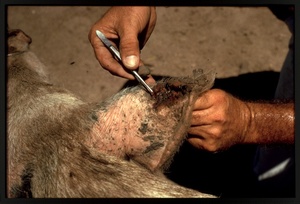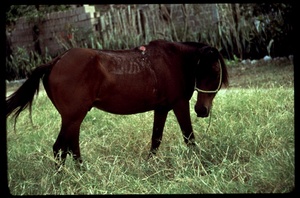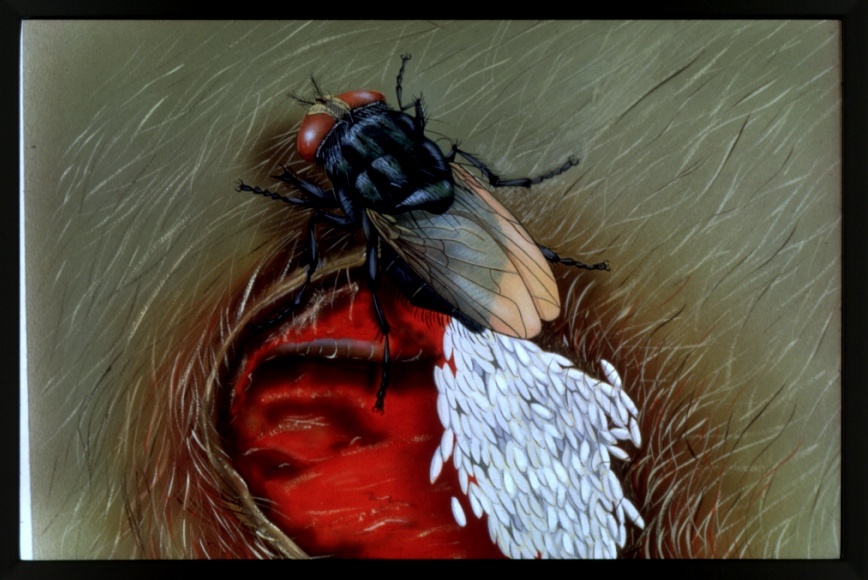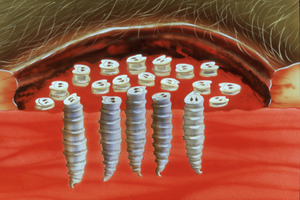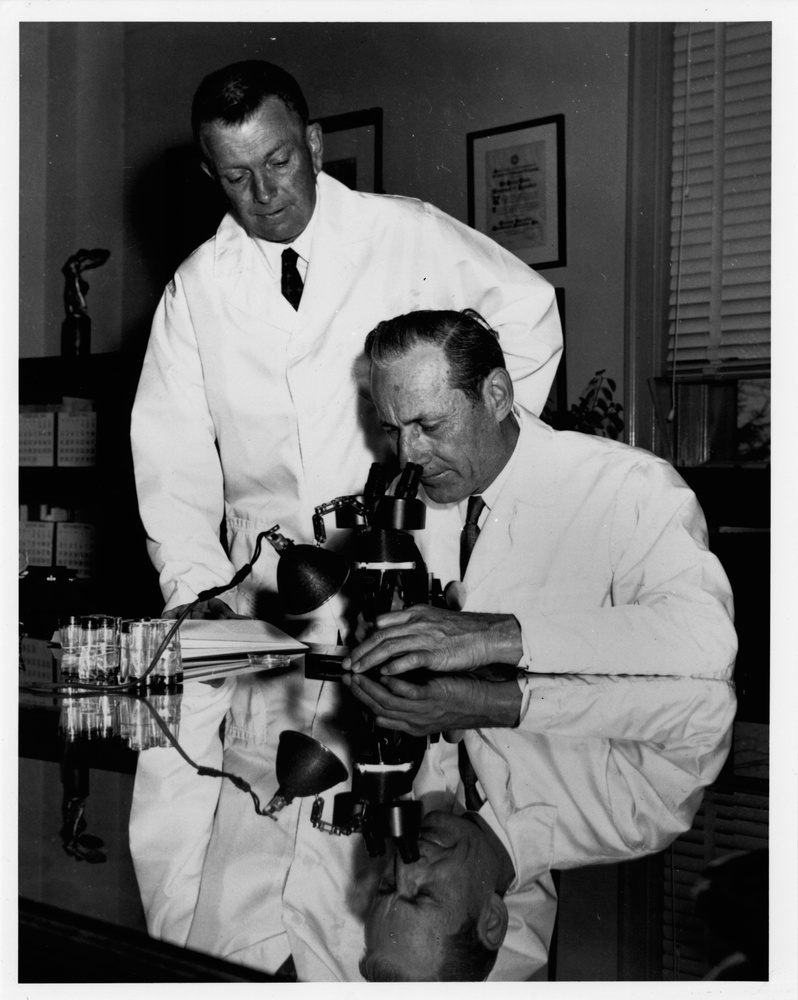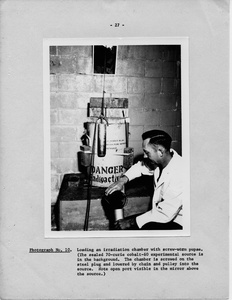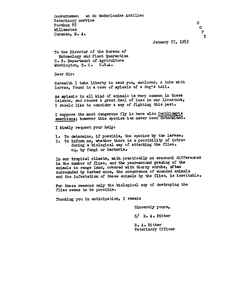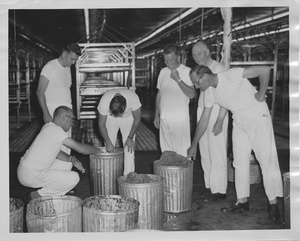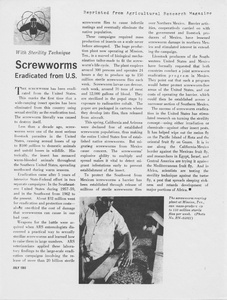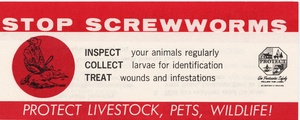Introduction
The New World Screwworm
The New World screwworm, Cochliomyia hominivorax, is a primary parasite of warm-blooded animals. Before its eradication from North and Central America, it caused devastating losses among livestock and wild animals. In its natural state it lives only on the living flesh of mammals and birds. The damaging effect of the screwworm is easily seen on domestic animals.
The Story of Screwworm Eradication
The materials here are selections from the Screwworm Eradication Collection and related collections, housed in Special Collections of the National Agricultural Library. The Screwworm Eradication Collection documents one of the greatest success stories in the history of agriculture in the Americas. Led by the U.S. Department of Agriculture (USDA), the campaign to eliminate the screwworm in the United States was succeeded by eradication programs in Mexico, Central America, and Jamaica.
The Impact of Screwworm Eradication
USDA estimates that the U.S. livestock industry benefits by more than $900 million a year as a result of the eradication of the screwworm. Mexican producers and consumers saved about $2 billion from the beginning of eradication to 1991. A 1995 Texas A&M University study evaluated the direct benefit to the Central America livestock producers at $73 million a year and overall economic benefits to the region at $257 million annually. The benefits to Mexico were estimated at $275 million annually from 1991 to 1994. In addition there are the benefits of enhanced human and animal health and increased standards of living due to the removal of this deadly insect. Endangered wild species have a better chance of survival. Additional grazing areas previously subject to high rates of screwworm infestation are now available for use by livestock and wildlife. The quality of life for smaller farmers and ranchers, especially in Central America, was improved by relief from lost man-hours needed to treat livestock and risk of loss from screwworm infestation. These benefits were made possible by the close cooperation of federal and state governments, individual producers, and producers' alliances to financially support eradication, as well as with activities that tracked infestations and allowed them to be treated. USDA scientists, primarily from the Agricultural Research Service (ARS) and Animal and Plant Health Inspection Service (APHIS), achieved the scientific and technical advances that made eradication possible.
The Life Cycle of the Screwworm
New World screwworm or American primary screwworm, known now by the scientific name Cochliomyia hominivorax (Coquerel) is endemic only to the Americas. Scientists once confused C. hominivorax with the blowfly, C. macellaria, which feeds on decaying matter. Some categorized the New World screwworm as C. americana or Callitroga hominivorax before the scientific community agreed on Cochliomyia hominivorax. The life cycle of the insect lasts about 21 days in warm weather and slightly longer in cooler climates. The adult female mates only once and lays her white, elongated eggs along the edges of wounds on warm-blooded animals.
The Larval Stage
Infestations are possible in smaller animals such as cats, dogs, and birds but the greatest economic impact is on larger animals such as pigs, goats, sheep, deer, and cattle. Even humans are susceptible to infestation, often in the nose or sinus cavities. Left untreated in humans, livestock, or wild animals, the egg masses hatch into swarms of larvae”the "worm" stage”which embed themselves in the host's flesh and consume the living tissue and fluids. The appearance of the larvae and the way they burrow into the host's flesh give the screwworm its common name. Feeding screwworms enlarge the wound and attract additional female flies, which deposit more and more eggs in the wound. If the infestation remains untreated, the host animal has little chance of surviving the secondary infections that often follow.
The Pupal Stage
The larvae gorge for several days to provide nourishment for the next stage in their development. Once mature, they drop to the ground and burrow shallowly into the soil. There they develop a dry outer shell and enter the pupal stage. The pupae undergo metamorphosis into adult flies.
Adult Flies
Adult flies emerge from the pupae and soon begin mating, to repeat the cycle. Screwworm flies are blue-green, have three dark stripes on their backs, and have orange eyes; they are about twice the size of a housefly.
Theory and Research Leads to Eradication Techniques
The work of many people and institutions over decades contributed to the eradication effort, which now has the screwworm in retreat as far south as Panama. Throughout, research in theory and practical application by ARS scientists and laboratories made the eradication process possible. In particular, three scientists”Dr. Emory Cushing, Dr. Edward F. Knipling, and Dr. Raymond C. Bushland”performed the basic analyses and created the techniques underpinning the effort.
The Discovery of Cochliomyia hominivorax, Mass Rearing, and the Sterile Insect Technique
Cushing, in collaboration with Dr. Walter S. Patton of the University of Liverpool, established that the screwworm fly was not the same species as the more numerous blowfly, which feeds on dead animals. Following publication of this discovery in 1933, research began to focus on control of the pest. Key to the endeavor was Knipling's theory that insect pests, such as the screwworm, could be controlled by inundating wild populations with sterile males. Fertile females that mate with sterile males lay eggs that do not hatch. Reproduction would drop with each generation, eventually reaching zero if sterile flies continued to be introduced. Known as the Sterile Insect Technique (SIT), Knipling focused on ways to use it with the screwworm fly. Another element critical to eradication was in place by 1936: a way to raise large numbers of the flies for research without using live animals. At the Menard, Texas, research laboratory, Bushland developed a technique for rearing large numbers of the insects on a diet of ground meat, beef blood, water, and a small amount of preservative, such as formalin. The availability of large numbers of screwworms for laboratory research led to more effective treatment for infestations.
Dealing With Screwworms on Ranches and Farms
Treating infested livestock was a highly unpleasant, labor-intensive job. Ranchers had to check livestock often for infested wounds, and infested animals had to be treated and confined. Wound treatments progressed from pine tar oil to various smears of insecticide notable for their highly unpleasant odor. In 1935, screwworms resulted in 180,000 livestock deaths in under half the counties in Texas, in spite of the manpower and constant effort invested in keeping the insects at bay. Endemic to the Southwest, screwworms spread to the Southeast when producers unknowingly transported infested livestock there in 1933.
Nearing a Solution
By the late 1930s, the elements in place for a solution to the screwworm problem were
- knowledge that the screwworm was a separate species, with a dependence on live hosts,
- Bushland's technique for raising large numbers of flies,
- Knipling's understanding of the species' mating patterns, and
- Knipling's theory for controlling the pest by the mass release of sterile males.
A fifth crucial element”a way to sterilize large numbers of screwworms”was not yet available.
Sterilization by Radiation
World War II intervened and entomologists of USDA's Bureau of Entomology and Plant Quarantine, including Knipling and Bushland, were assigned to the Orlando, Florida, station to take part in research for controlling insects that threatened U.S. servicemen and women. The rapid development of atomic research provided the fifth crucial element needed to eradicate the screwworm: a way to sterilize large numbers of screwworms, which as adult flies could compete for mates in the wild. After the war, Bushland was assigned to the Livestock Insect Laboratory in Kerrville, Texas, part of the Agricultural Research Administration, which later became ARS. Knipling directed research on insects affecting livestock and humans from headquarters in Washington, D.C. In 1950, Alfred W. Lindquist, a colleague, drew Knipling's attention to an article by the Nobel Prize winner Dr. Hermann J. Muller on the sterilization of flies by radiation. Knipling saw this as a potential solution to the problem of mass sterilization. Bushland arranged to use hospital x-ray equipment to test whether radiation could effectively and efficiently sterilize large numbers of C. hominivorax. The experiment was a success, and cobalt-60 gamma ray equipment from Oak Ridge National Laboratory made it possible to sterilize masses of screwworm flies.
Field Testing the Sterile Insect Technique: Sanibel Island
Florida was selected to field test Knipling's sterile fly release technique. In the Southeast and the Southwest, the northern areas of screwworm infestation were insect free during the coldest winter months but were reinfested every spring by the movement of livestock and insects from the warmer areas to the south, where the screwworm could overwinter. In the Southeast, these areas were central and south Florida. If these areas could be rid of screwworms, then the entire Southeast would benefit from eradication. A small, isolated area”Sanibel Island, a few miles off the southern Gulf coast”was chosen to prove the efficacy of the technique. Small planes released hundreds of sterile flies over the island. On the ground, scientists checked fly traps for the number of sterile to fertile flies and the overall number of flies trapped. The number of flies diminished quickly and dramatically, yet there was a small but steady reinfestation from the mainland. Researchers needed a more isolated site to prove their theory.
The Curaçao Experiment: Eradication
In early 1953, Knipling's attention was drawn by a letter from the veterinary officer B.A. Bitter on the island of Curaçao in the Netherlands Antilles, 40 miles from the coast of Venezuela. Bitter asked USDA for help treating the screwworm problem there. Curaçao turned out to be the perfect field site. It claimed a sizable population of domestic animals, it was small enough to conduct controlled field tests, and researchers believed it was far enough from South America to prevent fly migration. In 1954, screwworm flies were mass reared in Orlando, Florida, by USDA scientists and flown to Curaçao, where 400 sterile males per square mile were released by air. Effective eradication was achieved in 10 weeks.
Eradication in the Southeastern United States
By 1958, under the urging of Florida livestock producers, including the Florida Cattlemen's Association, the Florida legislature appropriated funds for a full-scale screwworm eradication program. The federal government provided matching funds, and a larger insect production plant was built in Sebring, Florida. Under full production this plant produced 50 million sterile flies per week.
Eradication in Florida and the Southeast
A severe winter in 1957-1958 drove the screwworms into a smaller overwintering area than usual. A rapid release of sterile males created a barrier zone across central Florida beginning early in 1958. For the rest of that year and the next, heavy and then lighter concentrations of flies were air dropped into 3 Florida zones. Although sterile fly releases continued through the end of 1959, screwworms disappeared from Florida and the Southeast earlier in the year. The Southeast was kept screwworm free by livestock inspection and quarantine, as well as occasional concentrated fly releases in areas accidentally reinfested by livestock from other areas.
Eradication Efforts in the Southwest: Rancher Support a Key
Next scientists focused on eradication in the Southwest. With funds from southwestern livestock producers, especially the Southwest Animal Health Research Foundation (SWAHRF), the federal government, and the State of Texas, eradication began in 1962. ARS labs in Kerrville and Mission, Texas, began production of sterile flies. The Southwest program covered a much larger area than the Southeast, and the Southwest was constantly at risk of reinfestation from Mexico. Efforts included not only mass release of sterile flies, but also relied heavily on the participation of livestock producers to treat animal wounds before and after they became infested. Producers also collected eggs and larvae from infested animals to be sent to USDA laboratories so that the effectiveness of eradication over this large geographical area could be assessed and areas of outbreak or hot spots could be blanketed with sterile flies. Eradication also depended on strict production and inspection procedures to disinfect and examine livestock that came from outside the Southwest. These efforts were so successful that USDA declared the United States free of indigenous screwworms as early as 1966.
Obstacles to Continued Eradication
Because screwworm populations that infested the Southwest overwintered in Mexico and Central America, Mexico's cooperation was essential to success in the United States. Screwworm outbreaks in central and southern Mexico and Central America were difficult to control. Eradication efforts in these countries required an increased concentration of sterile flies, first from the production facility in Mission, Texas, during the 1960s, and later from the Chiapas, Mexico, facility built in 1976. ARS and APHIS researchers developed new strains of screwworm flies that were more effective in competing with native males, as well as new feeding techniques for the larvae. A severe screwworm outbreak in the United States in 1972 demonstrated the continuing vulnerability of U.S. livestock to the spread of screwworm from the flies' own flight range and from the movement of infested animals. The Screwworm Eradication Program Agreement between the United States and Mexico was signed the same year.
Eradication Efforts Move to Mexico
Eradication in Mexico proceeded slowly. Scientists introduced various strains and new techniques, such as a combination of screwworm fly attractants and insecticides in pellets, known as Screwworm Adult Suppression System (SWASS). Screwworms were essentially eliminated from northern Mexico in 1982, the last year Texas reported a case of infestation. By the following year, the new production plant in Tuxtla Gutierrez, Chiapas, Mexico, produced 500 million flies per week, moving fly production closer to the barrier zone as the screwworm was driven south. Authorities planned for a permanent barrier zone at the Isthmus of Tehuantepec in the original Mexico-United States Screwworm Eradication Program, but it was clear by the mid-1980s that an eradication plan extending to the Darien Gap in Panama would be more beneficial.
Success Against the Screwworm in Central America
In 1993, Mexico recorded its last screwworm outbreak, a success in large part tied to eradication programs under way in countries to the south. There were over 10,000 screwworm cases reported in Guatemala in 1988, the year eradication efforts began, and only two reported cases in 1993. The insects were gone from Belize in 1992, El Salvador in 1994, and Honduras by 1996. Nicaragua was declared screwworm free in October of 1999. In January 2000, Costa Rica continued to receive eradication treatment with release of 60 million sterile flies per week. A screwworm production facility in Panama using the latest rearing techniques and improved strains (anticipated in 2003) will become a permanent facility to maintain the barrier zone at the Darien Gap between Central and South America.
 An official website of the United States government.
An official website of the United States government.


